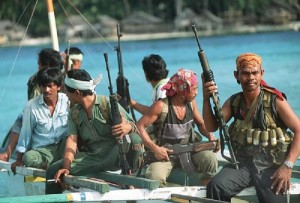President Rodrigo Duterte demonstrated his good faith in China again on January 31 when he said at an oath-taking ceremony for Philippine military officers that he had asked China if it could patrol the international waters near the Philippines, to help tackle piracy.
Duterte was referring to the Sulu Sea. According to the International Maritime Bureau, in 2015, the number of piracy cases in Southeast Asia accounted for 71 per cent of the global total. Last year, the number of maritime kidnappings hit a 10-year high.
Last year, the Philippines, Malaysia and Indonesia agreed to conduct joint maritime operations in the three nations’ waters. The so-called Sulu Sea Patrol Initiative aims to match the success of the Malacca Strait Patrol, which, since it was initiated in 2004, has significantly reduced hijackings and kidnappings in the strait.
However, the situation in the Sulu Sea is more complicated. The sea covers a much larger area, and the collective military capabilities of the three navies and coastguards fail to impress. Both Malaysia and the Philippines are short of patrol vessels and aircraft, which in part explains why Malaysia plans to buy Chinese-built littoral mission ships. Although the Indonesian navy is the largest in Southeast Asia, it has to, first of all, patrol its lengthy archipelagic coastline, which is also plagued with piracy. In fact, more than half of the incidents in Southeast Asia occurred in Indonesian waters.
Piracy surge could turn Southeast Asian waters into ‘new Somalia’, Indonesia warns.
China ‘likely to agree to Duterte’s request for anti-piracy patrols’
Duterte is right that external help is probably needed to resolve such an issue. But for China to consider his proposal, he needs to provide details, including specifying the exact location of where China might help. So far, he has mentioned “the international waters” in the south Sulu Sea. Such ambiguity could cause confusion, especially given the territorial dispute between the Philippines and Malaysia over Sabah, which raises the question of where the territorial waters of the two countries are.
The Asean community bears prime responsibility in securing an important shipping lane in its own region
His remarks that these patrols could only be done by the Chinese coastguard, rather than the Chinese navy, are also flawed, legally speaking. According to international maritime law, any warships, military aircraft or other ships on government service of a state may seize a pirate ship or a ship taken by piracy on the high seas. To put it bluntly, they don’t even need an invitation to do so, as long as they are on the high seas.
But the Chinese and Philippine coastguard can indeed cooperate as he wishes. During Duterte’s visit to China last October, the two countries signed a memorandum of understanding to establish a joint coastguard committee on maritime cooperation. Such cooperation may not necessarily be confined to the South China Sea, where China and the Philippine have territorial disputes; it may also include the Sulu Sea, where China’s assistance is needed. The two countries may conduct joint patrols or collective patrols involving other stakeholders.
A good example is that, since 2011, China, Laos, Myanmar and Thailand have been conducting joint law-enforcement patrols along the Mekong River.
In a similar manner, the Chinese and Vietnamese navies have so far conducted 21 joint patrols in the Beibu Gulf (Gulf of Tonkin).
China can help the Philippines in maritime capacity building. China, among other stakeholders, has over the years provided technical support for the security of the Malacca Strait. In the Gulf of Guinea, where piracy is also rampant, most of the navies of the littoral states have Chinese-made boats or light frigates. Similarly, China can provide technical assistance and training to the Filipino navy and coastguard.
Duterte could also approach the Association of Southeast Asian Nations for help. After all, the Asean community bears prime responsibility in securing an important shipping lane in its own region. More than 100,000 ships pass through the waterway each year, carrying 55 million tonnes of cargo and 18 million passengers. Since Asean aspires to play a central role in the security architecture of the Asia-Pacific region, it needs to showcase its solidarity, responsibility and even capability in the fight against piracy in Southeast Asia.
[Filipino President Rodrigo Duterte and Postmaster General Joel Otarra unveil a special stamp to commemorate the Philippines’ Asean chairmanship of the Asean summit this year. Duterte could approach Asean for help in improving maritime security. Photo: EPA] Philippines seeks US, China help to fight pirates
China should not be the only external power from which to seek help. Since 2010, Asean countries have been working with eight regional powers in an Asean Defence Ministers’ Meeting mechanism to address, among other matters, maritime threats in the region. So far, a number of exercises at sea have been organised and conducted under a maritime security group, but no real situation has been addressed. Could the working group start to discuss the situation in the Sulu Sea? The hope is that such discussions may, over time, lead to operational coordination. This is exactly how the Shared Awareness and Deconfliction (Shade) meetings, attended by more than 20 navies, have become useful in addressing piracy in the Horn of Africa.
If Duterte can eventually persuade other Asean members and external powers to agree to establish an international transit corridor in the Sulu Sea, like the current one in the Gulf of Aden, he will not be far away from success.
Source: South China Morning Post
Copyright Ships & Ports Ltd. Permission to use quotations from this article is granted subject to appropriate credit given to www.shipsandports.com.ng as the source.
